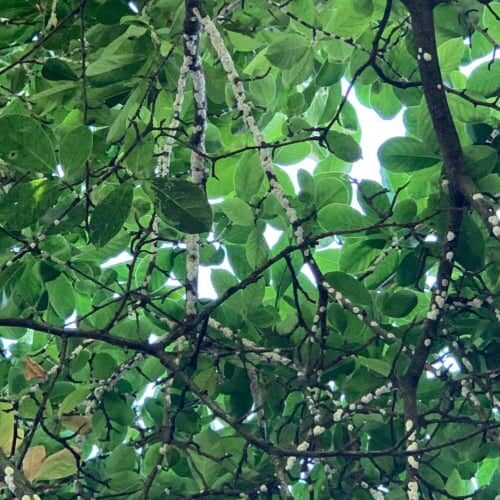Magnolia Scale, one of the largest soft-scale insects in North America, is a common and challenging pest that targets magnolia trees. These pests can cause significant damage if left untreated, leading to weakened trees, stunted growth, and unsightly black sooty mold. Understanding the life cycle of magnolia scale and implementing effective treatment protocols are crucial for maintaining the health and beauty of your magnolia trees.
Identification and Life Cycle
Mangnolia scale (Neolecanium cornuparvum) can be identified by their large, oval, and slightly rounded bodies. They range in color from pinkish orange to dark brown, and as they mature, they produce a waxy coating that can make them appear white or gray. These pests typically infest the twigs and branches of magnolia trees, feeding on sap and excreting a sticky substance called honeydew. This honeydew promotes the growth of sooty mold, which can cover leaves and branches, reducing photosynthesis and overall tree vigor.
The life cycle of magnolia scale involves several stages:
- Eggs: Laid by adult females in late summer, hatching into crawlers in late summer or early fall.
- Crawlers: Tiny, mobile nymphs that spread to new feeding sites on the tree. This stage is the most vulnerable target for late summer insecticidal treatments.
- Nymphs: After settling, the crawlers become stationary and molt into nymphs, gradually developing into adults.
- Adults: Mature scales produce eggs, continuing the cycle.
Symptoms of Infestation
Infested magnolia trees exhibit several symptoms:
- Honeydew and Sooty Mold: Sticky honeydew on leaves and branches, followed by the growth of black sooty mold.





- Yellowing Leaves: Chlorosis or yellowing of leaves due to nutrient depletion.
- Twig and Branch Dieback: Severe infestations can lead to dieback of twigs and branches.


- Presence of Scales: Visible scales on branches and twigs, often appearing as waxy lumps, are a clear sign of infestation.

Control Measures
Effective management of magnolia scale involves a combination of cultural practices, monitoring, and chemical treatments. Here is our recommended treatment protocol:
- Systemic Insecticide Application:
- Imidacloprid: Applied as a soil drench or trunk injection, imidacloprid provides a 12-month suppression of magnolia scale by being absorbed and distributed throughout the tree’s vascular system. This systemic approach ensures that the insecticide reaches feeding scales, reducing its population.
- Dinotefuron: In cases of severe infestations, dinotefuron offers more immediate suppression. This systemic insecticide can also be applied as a soil drench or trunk injection, quickly knocking down heavy-scale populations.
- Insecticidal Spray Applications:
- Timing: Spray applications are most effective when timed to target the vulnerable crawler stage of the magnolia scale’s lifecycle. This usually occurs in early to late August, depending on heat accumulation and growing degree days (GDD).
- Repeated Applications: Magnolia scale infestations typically require several seasons of treatment to achieve good suppression and control. Consistent monitoring and repeated applications ensure long-term success.
- Cultural Practices:
- Pruning: Remove and destroy heavily infested branches to reduce scale populations and improve air circulation within the tree canopy.
- Watering and Fertilization: Maintain tree health by providing adequate water and nutrients, which can help trees recover from scale infestations and reduce stress.
Magnolia scale is a persistent pest that requires diligent monitoring and management to protect your magnolia trees. By understanding the life cycle of this pest and implementing our comprehensive treatment protocol, you can keep your trees healthy and vibrant. If you suspect a magnolia scale infestation or need assistance with treatment, contact Homer Tree Care’s expert arborists for a free estimate and professional advice. Stay vigilant and proactive to ensure the beauty and health of your magnolia trees!

